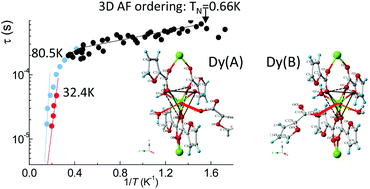{Dy(α-fur)3}n: from double relaxation single-ion magnet behavior to 3D ordering†
Abstract
The synthesis and magnetostructural properties of a new low-dimensional magnetic system based on α-furoate

* Corresponding authors
a
Escola Universitària Salesiana de Sarrià, Passeig Sant Joan Bosco 74, 08017-Barcelona, Spain
E-mail:
ebartolome@euss.es
Fax: +34 932806642
Tel: +34 932805244
b Instituto de Ciencia de Materiales de Aragón, CSIC-Universidad de Zaragoza, Pedro Cerbuna 12, 50009 Zaragoza, Spain
c Institute of Chemistry, Academy of Sciences of Moldova, Academiei 3, Chisinau, Moldova
d Institute of Macromolecular Chemistry “Petru Poni” Iasi, Aleea Grigore Ghica Voda, nr. 41A, 700487 Iasi, Romania
e Servicio de Medidas Físicas, Universidad de Zaragoza, Pedro Cerbuna 12, 50009 Zaragoza, Spain
f Centro Universitario de la Defensa. Academia General Militar, Zaragoza, Spain
The synthesis and magnetostructural properties of a new low-dimensional magnetic system based on α-furoate

 Please wait while we load your content...
Something went wrong. Try again?
Please wait while we load your content...
Something went wrong. Try again?
E. Bartolomé, J. Bartolomé, S. Melnic, D. Prodius, S. Shova, A. Arauzo, J. Luzón, F. Luis and C. Turta, Dalton Trans., 2013, 42, 10153 DOI: 10.1039/C3DT51080H
To request permission to reproduce material from this article, please go to the Copyright Clearance Center request page.
If you are an author contributing to an RSC publication, you do not need to request permission provided correct acknowledgement is given.
If you are the author of this article, you do not need to request permission to reproduce figures and diagrams provided correct acknowledgement is given. If you want to reproduce the whole article in a third-party publication (excluding your thesis/dissertation for which permission is not required) please go to the Copyright Clearance Center request page.
Read more about how to correctly acknowledge RSC content.
 Fetching data from CrossRef.
Fetching data from CrossRef.
This may take some time to load.
Loading related content
